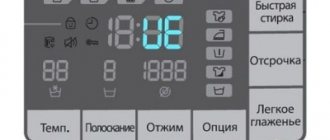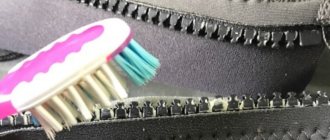A sweater is a universal and all-season clothing. For cold winters, choose models knitted from thicker yarn; for warmer seasons, knitwear or acrylic. But over time, any product develops one unpleasant feature - the elastic bands at the bottom and on the cuffs stretch.
And although the sweater still allows you to keep warm, it doesn’t look at all the way you would like. You shouldn’t rush things and classify your favorite thing as out of use: it can still be fixed. How? Read about it below.
@nashsovetik.ru
Causes of deformation
Having discovered that the product has lost its previous shape, you first need to understand the causes of the deformation in order to know what to deal with to prevent it:
Read also: History of Witches Page Post
- Perhaps the most important of them is the composition of matter. All sweaters and voluminous cardigans are made of elastic materials, which tend to stretch. They can be reduced in ways that we will outline below.
- If you wear something every day, then frequent wear can also cause it to become deformed. Basically, the sleeves are stretched and the length of the product increases.
Important! This can also be caused by improper cleaning products, washing, ironing, and drying regimes.
When something like this happens to your favorite item, the desire to wear it disappears. It may seem to you that nothing can be done and all that remains is to throw it away and buy a new sweater. However, do not rush to make hasty decisions, because it can be pulled back.
What if only part of the sweater lost its shape?
It happens that only part of the sweater has lost its shape, for example, the sleeves have stretched or the neck has become shapeless. What to do in such a situation? There is no need to wash the item completely . Use a spray bottle to spray hot water on the stretched area or submerge the area in hot water. Then spread the jacket on a towel placed on a hard, flat surface and shape it into the desired shape by gently moving the fibers with your palms towards each other.
Read also: What color goes with milk?
How to “pull” the elastic on a sweater
Due to the fact that the elastic band of the sweater neck is narrower than the head, and the cuffs are narrower than the hands, they tend to stretch over time. To remove shapelessness, wet the elastic with water, lay the jumper on the floor and move the threads towards the middle. For greater effect, you can use needles or pins. Pin the elastic in several places with them and leave until the item is completely dry.
Share on social media networks:
A sweater is the most comfortable and cozy clothing. Agree that it is so good to wear this warm, comfortable thing in gray and rainy clothes or in the cold in winter. If you know how to choose the right combinations, then you can wear a sweater anywhere - from a date in a cafe to an important meeting in the office.
Nowadays you can buy it in completely different styles and colors - for every taste and color. It is worn by both women and men. However, despite a lot of advantages, sooner or later every owner has to face a problem when the elastic on a sweater, neck or cuffs has stretched, what to do in this case and how to fix it? This is what we will talk about.
How to shorten the sleeves of a jacket with cuffs
As with lining and buttons, cuffed sleeves are often found on denim jackets. To shorten such a sleeve, follow these steps.
- Measure the required length on the sleeves of the jacket using a chalk.
- Remove the cuffs from the sleeves using scissors.
- Pin the sleeves of the jacket along the shoulder and side seams.
- From the control mark at the bottom of the sleeves, subtract the width of the cuffs and add 1 cm to the seam: cut the sleeves at this mark.
- Pin the sleeves at the bottom just above the marked line.
- Trim the excess, straighten the cut line.
- Open the cuffs of the jacket, iron them and cut them along new contours.
- If the cuffs have elastic, then leave a small hole for it.
- Fold each cuff in half lengthwise and machine stitch the layers of fabric together.
- Finished cuffs are attached to the new sleeve line using a sewing machine.
- At the end, insert the elastic into the cuffs, sew the ends together and straighten the cuffs.
Reducing individual elements
If the elastic band on a sweater has stretched, i.e. not the entire product, but its separate part (sleeves, neckline), then it can be restored separately without subjecting the entire fabric to water procedures. The jacket should be laid out on a flat horizontal surface. Use a spray bottle to moisten problem areas. When the fabric gets wet, it should be pulled so that the threads move in the opposite direction from the stretch. You can secure this position with a pin or rubber band. The sweater is left in this position until completely dry.
Read also: a child ate poison for ANTS HEELP
If the cuffs or other parts of the product have not stretched much, after moving the threads to the center, you can speed up the process of removing excess moisture. You can dry the sweater using an iron. To avoid damaging the fabric, it is recommended to iron the product through a piece of gauze folded several times. You can use a terry towel, but with each new ironing you should cover the jacket with the dry side.
Another method that cannot always be used to make a sweater smaller; in most cases, it is suitable for those products that were independently knitted. You can unravel the stretched part and then bandage it. To avoid having to unravel the entire sleeve if only the cuff is stretched, it is recommended to give preference to a needlework style that involves knitting from the elbow to the hand. There are fewer problems with the neck. In most cases, it is knitted separately from the body of the sweater and then sewn on.
How to stretch a wide elastic band on a skirt?
To quickly stretch the elastic on a skirt, lay the garment on an ironing board and secure it on both sides, stretching the elastic to the desired length. By the way, you can put the skirt directly on the board. Place a damp cloth on top and run an iron at maximum temperature.
Interesting materials:
How to enable ASUS XMP profile? How to enable downloading via mobile network? How to enable booting from a flash drive on Acer? How to enable booting from a flash drive in ASUS BIOS? How to enable booting from a flash drive in HP BIOS? How to enable booting from a flash drive in UEFI BIOS? How to enable booting from a flash drive in UEFI? How to enable UEFI boot instead of CSM? How to enable sticky keys on your keyboard? How to enable text replacement in Word?
Returning the sweater to shape
There are several ways to return things to their former sizes and volumes. You can choose the one that seems more suitable for your case.
“Wedge with wedge” for a sweater
So, you washed the item in the washing machine, after which you observe this opus. If the sweater is machine knitted, then you need to do a seemingly crazy manipulation - wash it in the washing machine again! But this time according to the rules:
- Place the item in a laundry bag (you will see this device in the photo) and load it into the drum of the washing machine.
- Add detergent specifically for washing wool to the compartment.
- Set to quick wash mode.
- Set the temperature to the minimum - 30 degrees will be enough.
- Be sure to turn off the spin! Replace with simply draining the water from the drum.
- Automatic drying must also be deactivated.
- When finished, remove the item from the bag and gently wring out the sweater by hand.
- Now we will start “reconstructing” it - lay the product on a towel or piece of fabric.
- Give the sweater the look that suits you - pull up the fabric on the sleeves, pull it in at the waist, adjust the neckline, etc. This is done like this: place your palms on the product and smoothly, grabbing the material, carefully move them towards each other, avoiding folds. You need to start this kind of work with the seams of the product, then move on to the neckline and sleeves, then tighten the rest.
- When the item is completely dry, it will literally harden in the shape you intended, so try not to miss anything when recreating the volume of the item.
And now a little secret for those who want to reduce a machine-knitted item by several sizes: the sweater needs to be washed at high temperature - this is the only change in the above algorithm.
Advice! During drying, be sure to monitor the condition of the towel. As soon as it becomes completely wet, it must be replaced with dry one. When transferring things, do not forget to put them into marketable form again. If you do not change the towels, the sweater will become saturated with an unpleasant moldy smell due to dampness.
Tips and tricks
Now you know what to do if your favorite sweater has stretched. However, it will never hurt to learn some tips that will help make the process easier and make it much more efficient:
- If you need to return a knitted product to its previous shape, it is best to use the manual method. For such things, it is best to purchase a special product, but you need to use it in small quantities. This will make rinsing the product much easier.
- If there are stains on the surface, it is better to get rid of them in advance with a stain remover or improvised product.
- The rotation speed of the drum, if we are talking about the method with a washing machine, should be high.
- To not only return the product to its shape, but also add a pleasant aroma, add a little lemon juice, essential oil or fabric softener to the water.
Important! If none of the methods helped you, and you knitted the product yourself, try undoing and re-shaping the elastic at the bottom, casting on the appropriate number of loops.
Washing machine
A wool sweater has stretched out after washing - what should I do? Alternatively, you can use a washing machine. You need to run a normal wash, but at the same time following some recommendations:
- Place the product in a special washing bag.
Important! You can buy it at any hardware store - the price is very affordable. However, if for some reason you still cannot purchase it, use a regular pillowcase.
- Choose a delicate wash cycle.
- You need to squeeze the item yourself, but without twisting it.
Manually
A sweater has stretched out after washing - what to do if you don’t have a washing machine? Of course, with the help of technology you can quickly deal with the problem without difficulty, but not everyone has it, so you can do everything manually. For this:
- Pour some warm water into a deep container and immerse the product in it.
- After fifteen to twenty minutes, when it is completely soaked, wring out the item.
- Place it on a voluminous terry towel and roll it into a tube.
- After a day or two, when the product has dried, leave it in the fresh air until completely dry.
The result will pleasantly surprise you.
Methods to prevent this problem
If you do not want to encounter this problem, then the only way to prevent your sweater from stretching is to properly care for it. To do this, remember the following:
- Wool items can only be dried in a horizontal position. Under no circumstances should you do this as you usually do with other things - hang it on a rope, this can greatly stretch the thing.
- Do not add large amounts of detergent when washing.
- The water should be warm - not cold or hot.
- If you dry the item outside, you should do it in the shade, as direct sunlight will make the sweater shine and also make the material coarser.
Important! You should not wear a sweater every day, since frequent wear is the main reason for things to stretch. Alternate it with other clothes, and at best, wear it once or twice a week.
So that this doesn't happen again
Naturally, it is best and easiest if you no longer have to deal with this problem. To do this, you need to follow a few simple recommendations:
Ironing should be done very carefully!
- Knitted items are washed only by hand and only in warm water.
- Washing in hot water leads not only to deformation of wool fibers, but also to their fading - high temperatures contribute to the rapid washing out of the dye.
- Do not add excessive amounts of detergent.
- Try to use liquid products rather than powders. The latter are more difficult to wash out of wool fibers.
- Do not twist the product while spinning! This will further lengthen and deform the fibers.
- Try to only use detergent that is designed for the material the sweater is made from.
- Do not dry knitted items in a dryer, on hangers, or in any other hanging position! It is because of this that it stretches under its own weight.
The greater the distance between the loops, the more likely there will be stretching.
- The only optimal drying option is in a horizontal position, on a towel or other material.
- Do not dry wool on a radiator, in the sun or near other heat sources. This causes the fibers to coarse and become stiff, making wearing such a sweater uncomfortable.
- You can iron a woolen product only at the lowest temperature and only on the reverse side.
- Store the product rolled up in a closet. If it hangs on hangers, this can also cause stretching.
You now know what to do if your sweater stretches after washing. However, try to prevent this from happening - use our care tips.
Is it possible to return items to their original size?
It’s possible, but not for any sweater. Cotton, acrylic and synthetic materials are unlikely to be restored, but wool, cashmere or mixed types of threads with a high wool content can be returned to their previous state. A lot depends on how much the sweater is stretched .
The original size 46, stretched to 52, can be safely thrown into the trash, and if the item has stretched one size or only the sleeves or neck have stretched, there is no reason to panic. It will take a little effort and time for the sweater to regain its previous shape.
dry it “correctly”
After washing, stretched items should be dried in a horizontal position. To do this, you will need a large towel or thick fabric that absorbs water well. Lay out the sweater on a spread towel and start tidying it up. Gently pull the sleeves horizontally and vertically. Pull in the neckline and waist. Use your palms to move the fibers around each other throughout the product. Now you are a sculptor who cuts off everything unnecessary, giving the product the desired shape.
Make sure that the towel on which you dry the item is not too wet. It is advisable to change it several times so that the sweater does not absorb the smell of moldy dampness. You can dry a sweater only naturally, without resorting to a battery, hair dryer, steam generator or sunlight. Too much heat can cause the threads to become distorted.
We suggest you familiarize yourself with How to remove yellow deposits from a toilet and clean the lid
Sewing the jacket to size yourself
Now let's look at how you can sew a jacket yourself, depending on where it is too big.
How to sew a jacket at the waist
One of the easiest ways to reduce your clothing size.
- The first step is to baste the outline of the seam with bright threads.
- In order to get to the side seam and back, you need to open the hem inside the jacket. Decide on the size and use chalk to mark a line along which you will sew the item in the future.
- Next, sew the stripes on the sewing machine, having previously selected the stitch width.
Typically its value ranges from 3.5 mm to 4.5 mm.
- After finishing with the inside, proceeds to the lining. You need to repeat the same actions with her.
At the end of the work, you should try on the updated jacket.
How to sew a jacket on the back
For this option, you also need to decide on the scale and at what seams you will sew the item.
- We turn the jacket inside out, and then do the same with the sleeve.
- Then we rip the lining on the sleeve at a distance of approximately 15 cm to 20 cm.
- The entire material should be pulled out through the hole you get. We machine sew the desired length in the center of the back.
- After stitching, turn the jacket back through the hole.
- The next step is to straighten the folds of the sections; to do this, fold the lining on the sleeve.
- And stitch the edges (two layers of fabric should be caught).











